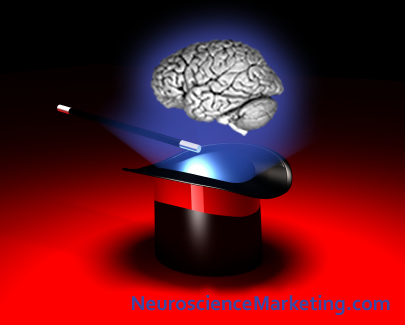Neuroscience and Magic

Magic tricks have entertained people for centuries, if not millenia. They startle and surprise the audience because the trick generally accomplishes something that appears to be impossible – a ball disappears when tossed in the air, a tiger materializes in an empty cage, and so on. Most magic tricks exploit limitations in human perception: when we are watching the magician’s right hand, we think we know what his left hand is doing but more than likely our brains are simply filling in the blanks for us. Surprisingly, until recently scientists have largely ignored the insights into perception and cognition offered by magic. It turns out that understanding why magic tricks work may help both neuroscientists and even marketers.
The Boston Globe has an interesting article describing how magic is starting to get the scientific recognition it deserves:
As magicians have long known and neuroscientists are increasingly discovering, human perception is a jury-rigged apparatus, full of gaps and easily manipulated. The collaboration between science and magic is still young, and the findings preliminary, but interest among scholars is only growing: the New York Academy of Science has invited the magician Apollo Robbins to give a presentation in January on the science of vision, and a team of magicians is scheduled to speak at next year’s annual meeting of the Society for Neuroscience, the world’s largest organization of brain researchers. [From The Boston Globe: How magicians control your mind by Drake Bennett.]
Magic tends to exploit our ability to focus on just one thing at a time, even when we seem to be taking in a lot more.
At any particular instant, we can only see detail and color in the small patch we are concentrating on. The rest we fill in through a combination of memory, prediction and a crude peripheral sight. We don’t take in our surroundings so much as actively and constantly construct them.
“Our picture of the world is kind of a virtual reality,” says Ronald A. Rensink, a professor of computer science and psychology at the University of British Columbia and coauthor of a paper on magic and psychology that will be published online this week in Trends in Cognitive Sciences. “It’s a form of intelligent hallucination.”
One key neuromarketing takeaway from this concept is that viewers, say, of a TV ad will be focused on one thing at a time and will likely not absorb elements that don’t have their attention. And how do you get their attention? One way, apparently, is with curved, semicircular motions. One magician and expert pickpocket says experience has taught him that that kind of motion draws and holds the attention better than straight motions. This led neuroscientist Susana Martinez-Conde to speculate that, ” the particular magnetism of curved motions might spring from the fact that they don’t map as easily onto the quick, straight movements, or saccades, that our eyes instinctively use to focus on objects. As a result, she suggests, curved motions might require more sustained attention and concentration to follow.”
The article is an interesting read. I’ve always thought that scientists paid too little attention to magic, with one result being bogus findings when studying individuals with supposedly paranormal powers. (It turns out, as skeptic and magician James Randi has demonstrated, that scientists unfamiliar with magic can be easily tricked.)
The article sums up, “And in a world where concentration is a scarce resource, a better understanding of how to channel it would have myriad uses, from safer dashboard displays to more alluring advertisements – and even, perhaps, to better magic.” Better magic, better marketing. A win-win for sure.
